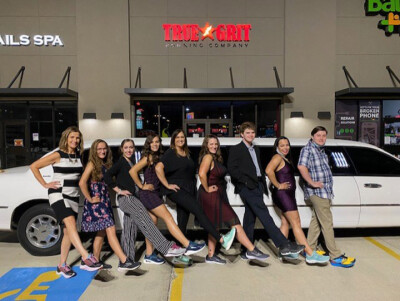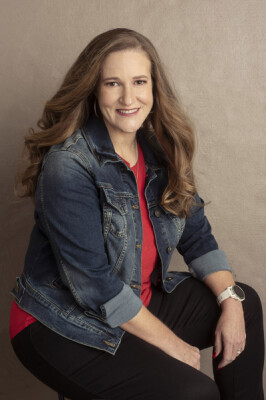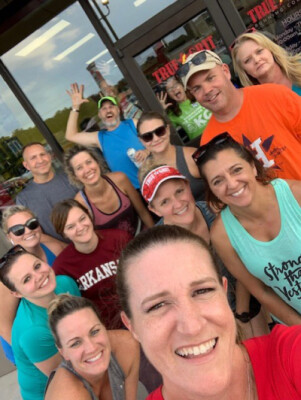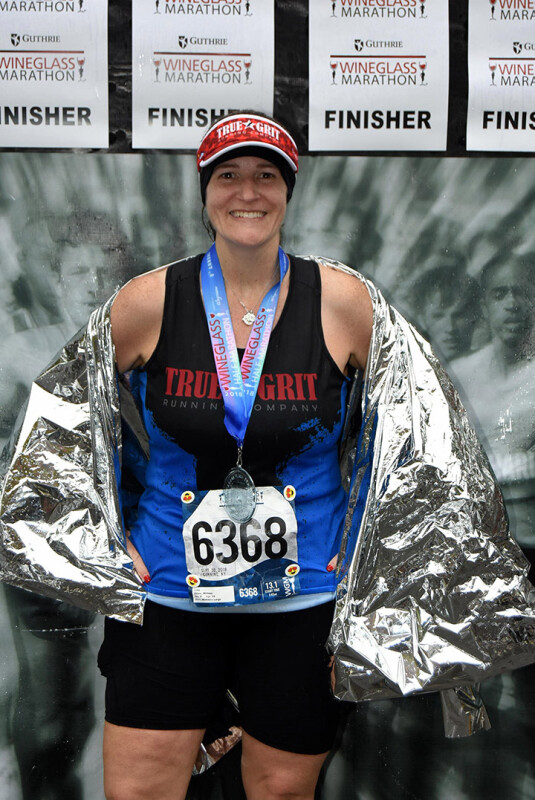Melissa Vitale came to run specialty retail from a job as an environmental, health and safety manager for a chemical company after having worked in R&D and applications for the ink and paint industry. While that certainly does not sound like ideal training for run specialty retail, there are similarities.
“Specialty retail is a completely different monster, but it’s still fun to work around all the different colors of shoes and apparel — I’m fascinated by color, why consumers select certain colors and the variety of messages transmitted by color,” Vitale explains. “Color choice can say a lot about someone’s personality or about how someone is feeling or wants to feel.” While she is no longer dealing directly with chemicals as owner of True Grit Running Company in Fort Smith, AR, she still views the technology behind running shoes and apparel as an example of chemistry working together for the greater good.
 With a background in chemicals and colors, how did you get into the run specialty retail business?
With a background in chemicals and colors, how did you get into the run specialty retail business?
The idea for having a running store came to me a couple of years before I actually took the plunge. There was no store in Fort Smith and I felt that it could certainly use one.
How has that changed since you opened the store?
It’s been a wild five-year ride, but we’re still going strong. When I started I was the owner, accounts payable, fitter, buyer, janitor, training coach and anything else that needed to be done. As the store has grown, I’m not wearing as many hats — but if my team is busy on the floor and the toilet needs scrubbed before we can all go home, I’m on it.
So, how has the past year been for you, personally and professionally, in dealing with the pandemic?
By far, 2020 and 2021 have proven to be the toughest years professionally and personally — and, oddly enough, the pandemic has very little to do with it.
How’s that?
When COVID-19 first hit, I wasn’t too worried about it. I felt like it would be something the cities on the coasts would deal with primarily, and nothing for Arkansans to worry about. Boy, was I wrong!
Yes, as were many of us. So what happened next?
As lockdowns began to spread I became extremely concerned. What would Arkansas do? What would Governor Hutchinson announce? We watched the press conferences every day, waiting to hear. We eventually learned that Arkansas would not fully shut down.
So what did you do then?
Like many stores, we pivoted — we adjusted our hours, started making appointments, canceled group runs and activities, sanitized between customers and limited the number of customers inside at one time. We offered curbside and delivery. Then May hit. Everyone realized this was going to be around for a while and if they couldn’t go to the office, gym, the movies, a restaurant or run races they could still get outside in their neighborhoods or learn our trail system. And we haven’t slowed down since.
What other events shaped the past 20 months for you?
I ran my last race on March 1, 2020. My right knee had been giving me some problems for a few months, but nothing too significant. After this race, however, I knew something really wasn’t right. With COVID, it was impossible to see a doctor or get an appointment, so I waited until things opened up some. In May 2020, I learned that I had severe osteoarthritis in my right knee.
Well that doesn’t sound good.
According to the X-ray, my bones were already banging against one another. The MRI revealed a lot more going on inside there — torn medial meniscus, bone marrow edema, popliteal cyst, a thinning ACL. Ugh. No wonder. I was told to stop running, which we all know means “just do short distances,” which I did for a while, until the time to recover between runs became longer and longer. My knee just couldn’t take it anymore. The orthopedic said I would need a partial knee replacement. Whoa. I wasn’t ready for that news. I’m only 45.
How did you pivot personally then?
As luck would have it, an OrangeTheory opened up two doors down from my store. I discovered I could run on the treadmills there, as they reduce impact up to 40 percent. This at least allowed me to do some running and, hey, it wouldn’t hurt to learn to row and do some resistance training while I was at it. Races weren’t happening and any running goals had been thrown out the window between COVID and my knee injury.
Did you take advantage of OrangeTheory’s April “Marathon Month?”
Yes, it is a program where you can work to complete a half, full or ultra marathon on the treadmills during class time. You add up your distance over the entire month and if you met your goal, you get a medal. Obviously, I was down for the challenge. They moved it to November (since April was a bust for everyone), and I signed up for the full.
How’d that go?
Sometime before Thanksgiving, I felt I had pulled a muscle in my back. Nothing major, just a little twinge. Just give me some IcyHot, Advil and I’ll keep going — except that didn’t work. I went to OrangeTheory on Thanksgiving morning. I put some IcyHot on before heading to Thanksgiving dinner. I went to the restroom and I realized I was numb. I couldn’t feel parts of my leg. And my right buttock was numb. Something was really wrong.
It keeps getting worse!
Yes, and eventually, I couldn’t sit or stand for very long without being in pain. I worked Black Friday and Small Business Saturday, and I had 0.66 miles left to go in my OrangeTheory Marathon. I had to finish before the 30th. On Monday, I went over there and only did the treadmill part of class to finish my Marathon. Boom — got it done.
Congratulations!
But I ended up in the ER the next day and they gave me steroids and muscle relaxers after X-raying my back and informing me that I had mild degeneration between my L5 and S1 vertebrae. They sent me home to relax and told me to come back if things didn’t improve. They didn’t improve — they got worse.
And then …
By Saturday, I was back in the ER via ambulance in excruciating pain. After a catheter, morphine, multiple tests and an MRI, I was told I would need immediate surgery to solve the problem. My poor husband was so stressed and I thought he was going to lose it because the monitor would beep incessantly anytime my heart rate went below 60. We finally explained to the nurses that I was a distance runner, so could they please change the settings to handle my lower resting heart rate.
Ah, the benefit of being a runner.
I would have emergency back surgery at 8:00 p.m. on Saturday night. I told the ER nurse and the nurse practitioner that I didn’t want back surgery — no one I knew ever had a good back surgery story. That’s when the nurse practitioner told me that they interrupted the neurosurgeon while he was in another surgery to show him my MRI results. He looked and said, “Put her on the schedule for tonight.” Evidently, this was an emergency.
 You have us worried now.
You have us worried now.
As I laid there, waiting for surgery, I felt relief as I looked and saw a familiar customer. My anesthesiologist was a fellow runner and a customer. The surgeon came and explained things to me. It turns out that the disc between L5 and S1 herniated, then actually sequestered — which means that parts of the disc had completely abandoned their post and were hanging out on nerve roots branching off of the caudal equina part of my spinal cord. I would also need a bilateral laminectomy at L5 to relieve the pressure on my spinal cord. I asked the surgeon, “If my knee was in perfect condition, and I have this surgery, am I going to be able to run again?” He said that in three months, I should be able to do whatever I wanted. I remember saying a prayer and being wheeled back into the OR.
How did your recovery go then?
Every time there was a shift change, the nurses would check to see if I could move my feet. Could I push/pull with my toes? Could I lift my leg and hold it for five seconds? It was eye-opening and scary. What if one time they came in and I couldn’t do those things? What would that mean? As a long distance runner, it was very strange when the physical therapists would come around with a walker and they’d get excited that I walked over 300 feet one day. I was used to doing 68,897.6378 feet on a regular basis — why are you so excited about 300?
What got you through all of this?
I tried so hard to remain positive, remembering what the doctor said. He said I’d be able to run again. Let’s be smart and do everything he asks. Like any run specialty owner, I discussed footwear with the PTs as they walked the 300 feet with me. “Would you believe me if I told you I owned the running store literally across the street from here?” Even if they didn’t believe me, I talked with them about footwear. Some of my nurses were customers. I recognized them and their footwear.
OK, tell us about the catheter.
The catheter had to be the most annoying part of this whole series of unfortunate events. I tried to imagine how one runs with a catheter. Can it be done? Having a catheter isn’t all that uncommon, so surely there are people who run with them. I just didn’t know any. A friend joked that it sure would be convenient not having to stop during a race or a long run — she had a point.
That’s what friends are for. So how did all of this impact your store?
During this time, I was able to work a few hours in the store every day. My mom would come pick me up, help me put on my shoes, and take me to the store. It was easier to get into her car than into my husband’s truck. And he had already missed a lot of work caring for me.
And you are back working out?
Six weeks post-surgery, I was cleared for workouts at OrangeTheory, but with weight restrictions and still no running — I’d have to use the bike or strider. I was surprised that I could use the water rower. Turns out, that machine doesn’t really engage the back muscles as much as I thought. I came to love the water rower. It was a place I could set new goals and challenge myself. And I’m pretty good at it, too!
How is your knee now?
My knee is still a huge problem. I’m scheduling partial knee replacement surgery for January 2022. Why not earlier? Last year was such a holiday bust and, sadly, we haven’t put up a Christmas tree in over three years at my house. It’s just been too busy. And last year it was just a physical impossibility. So, this year, there will be a Christmas tree in the Vitale house.
So a Merry Christmas is in the cards?
With shipping and inventory levels being what they are, there may not be any gifts under the tree. But that’s okay. I’m giving myself the gift of movement. Running long distances may no longer be in the cards for me, but running itself is. Running for the pure joy of it is still there.
We like that — the “gift of running.”
We may roll our eyes and chuckle at “the dinky community 5K that tries,” but I guarantee you this — I will never roll my eyes again at a starting line. It is a gift simply to toe the line. Here’s to hoping I’m able to do just that in late 2022.
So after all of that, what is your typical day like now?
My typical day is this: 5 a.m. workout at OrangeTheory. Home to cook breakfast and enjoy it with my husband. Off to the store to work. Leave at 7 p.m. to head to the Fort Smith Little Theatre, where I am currently producing a show called, “Parfumerie.” I head home once I have my tasks there complete, enjoy dinner and go to bed so I can get up and do it all again the following day.
Here’s a question that gets various responses: Do you view yourself as a woman in the run specialty business or simply a professional in the run specialty business?
I mostly view myself as a professional in the run specialty business. I suppose it may be because I’ve previously worked in a lot of male-dominated industries, but then again most industries were male-dominated until women began working more outside of the home. I’m used to working around and with a lot of men. There were times I felt like I had to work harder to prove myself, so I tried to do just that.
Many people feel that run specialty is actually more equal in gender participation than many other businesses. Just look around The Running Event (when we have it again back in Austin next month!) and see how many women are walking the aisles and working in the booths. Do you agree with this?
Run specialty may be more equal now than it was many years ago. I’ve only been in the business for five years, so it is hard for me to say. There may be more women in the industry, but probably not that many women owners of run specialty stores.
We hear that a lot.
I will say that I’ve had more connection to women owners, because I’ve met them through empowerun. I think there are more women in the industry today because the majority of race participants these days are women. Men may go run a race, but I’ve discovered that women will call it a “Girls Weekend” and plan a whole weekend getaway with their running friends — dinner, wine, running, laughter, shopping. I’ve done it many times. I don’t know a lot of my male running friends that do that.
What makes your local running community unique?
My local running community is unique in that somewhere along the way, it’s no longer about running. Yes, we’ll cheer you on and help you reach your next PR, but it is deeper than that. We pray for you. We circle the wagons when someone is in trouble. We cook meals or provide food when someone is ill or loses a loved one. We’re a family. And we’ll celebrate every finish line with you — whether you hit a new PR or rode the struggle bus all the way in, we love you just the same.
 What do you think you bring to your business with a woman’s perspective as compared to your male colleagues?
What do you think you bring to your business with a woman’s perspective as compared to your male colleagues?
This question is a hard one for me to answer. Personality-wise, I tend to think in a more masculine way. I don’t know that I personally bring much of a female perspective. My thought pattern is much more typically masculine than feminine. I am one of the least maternal people I know.
How does that translate to your leadership style?
I don’t know if this necessarily has anything to do with being female, but I will say that my leadership style is much more democratic than in some other places I’ve been. While the decision is ultimately up to me, I do seek input from a variety of sources – including my entire team – on certain things.
Do you think having a woman running the business has helped your store reach more female customers?
In some ways, yes. I honestly think that being a plus-sized runner for so long brought me more female customers than anything else. I think people have an idea of what they think a runner’s body looks like — and it’s usually the one elite runners have. There’s nothing wrong with it —heck, I’d love to look like that, but I don’t. Stand at any finish line and you’ll see all kinds of people crossing it. I think our communities need to have a better understanding of what a runner’s body looks like and realize that it looks much like they do.
What advice would you give to other run specialty retailers about reaching out and merchandising to female runners?
My advice regarding merchandising and reaching out to female customers is — just to do it. And show real women – actual customers and running buddies – doing it. If you can tell a success story of someone who maybe lost a lot of weight while running or of someone completing a race or training program — better yet, have them tell their story.
Anything else?
Be inclusive on sizing. People come in a variety of shapes and sizes and have different preferences. And not just extended sizes — all sizes have likes/dislikes. Remember runners also come in a variety of ages, not just sizes. Everyone performs better when they feel good and part of feeling good is looking good. Make sure everyone can find something that makes them look good and feel good in your store.
What advice would you give to any young (or older) women considering following a similar career path in the run business?
Have a solid network. Make contacts and stay in touch with them. Check in with a text or email from time to time. Being a store owner can sometimes feel very isolating. I am grateful for the women of empowerun — I no longer feel alone in my struggles. And I have a fantastic resource for answers to many questions. Find your tribe in the running industry — no matter who they are, and stay in touch.
Well, you have had quite an interesting year so far. What are you expecting for you and your store for the rest of 2021 and what is it going to take to achieve that?
We’re on pace to blow 2020 out of the water, we just have to hold strong. We know there are global supply chain issues and inventory struggles headed our way. We need to educate the customer on what’s coming and provide them with information so they can make their purchases wisely.
How do you do that?
We plan to be honest and upfront with them about what is going on and what our plan is going forward. It’s not always about supplying the product immediately — it’s providing them the information and support they need to make the best decisions they can.






